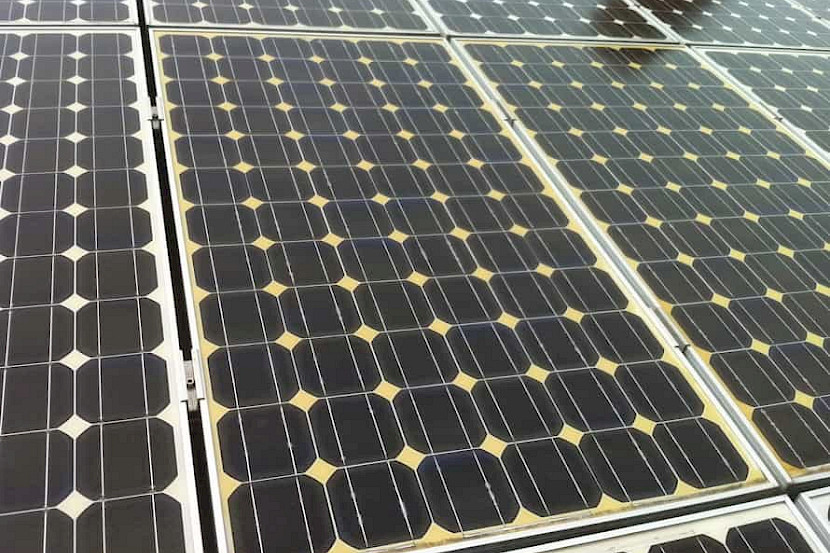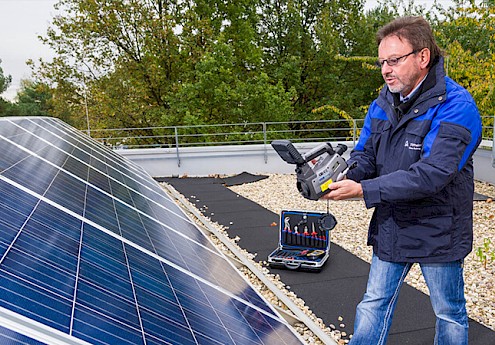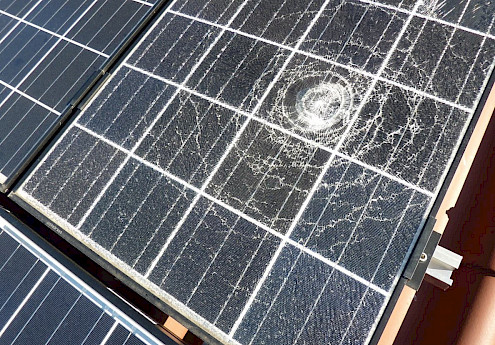
Error pattern: Discoloration of the EVA film (yellowing)
Where does discoloration of the EVA film (yellowing) occur?
The solar cells are the heart of the solar modules. These are embedded between two polymer films during the manufacturing process. This entire sandwich is in turn placed between a front glass and a rear film or rear glass and laminated. Usually, ethylene vinyl acetate (EVA) is used as the polymer film. This is a compound of the monomers ethylene and vinyl acetate. Depending on the ratio of the two monomers in the polymer, the EVA film has different properties. The central task of the EVA film is to hold the entire module composite together and to ensure good transport of the charge carriers from the solar cells to the junction box. If the module degrades, these actually transparent EVA films can change color. This is also known as yellowing. This is mainly visible on the front of the modules, but also on the back of double glass modules.

How can discolorations of the EVA film (yellowing) on the module be detected?
Die Verfärbungen von EVA-Folien sind gut zu erkennen. Sie treten in der Regel großflächig in der Mitte der einzelnen Solarzellen, umgeben von unverfärbten Ringen. Sie können sich aber auch über die gesamte Zelle erstrecken, die dann dunkler erscheint als die benachbarten Zellen.
What is the cause of EVA film discoloration (yellowing)?
The discoloration of EVA film is one of the most common consequences of degradation mechanisms in solar modules. It is mainly caused by the interaction of the film with UV radiation, heat and penetrating oxygen and acetic acid. This is because the EVA films are provided with additives including UV and heat stabilizers. If the concentration of additives is too low, discoloration can occur over time. Therefore, cells that become warmer than other cells may be more affected by the discoloration of EVA films.

What is the danger of discoloration of the EVA film (yellowing)?
Slight discoloration of EVA films, limited to individual cells, is initially primarily an aesthetic problem. This does not necessarily mean a safety problem if the bypass diodes are working. However, if they occur over a larger area, they can also contribute to a small extent to the faster degradation of the modules, which can ultimately lead to lower yields for the entire module.
How can discoloration of the EVA film (yellowing) be prevented and can the defect be repaired?
The discoloration of the EVA film is usually the result of inadequate selection of the raw materials for the module by the manufacturer. It is therefore not usually possible to take precautions against this discoloration. As the EVA film is an integral part of the solar module, the defect is usually also irreparable. As long as the discoloration is limited, it remains an aesthetic problem.
However, if the discoloration becomes more extensive, it can lead to a considerable loss of module performance over time, which in turn can have a negative effect on the yield of the entire module string. In such cases, it may be worth replacing the module. When replacing the module in question, it is particularly important to ensure that the replacement module matches the other panels in the string and in the system. You can find suitable replacement modules on the SecondSol online marketplace.


